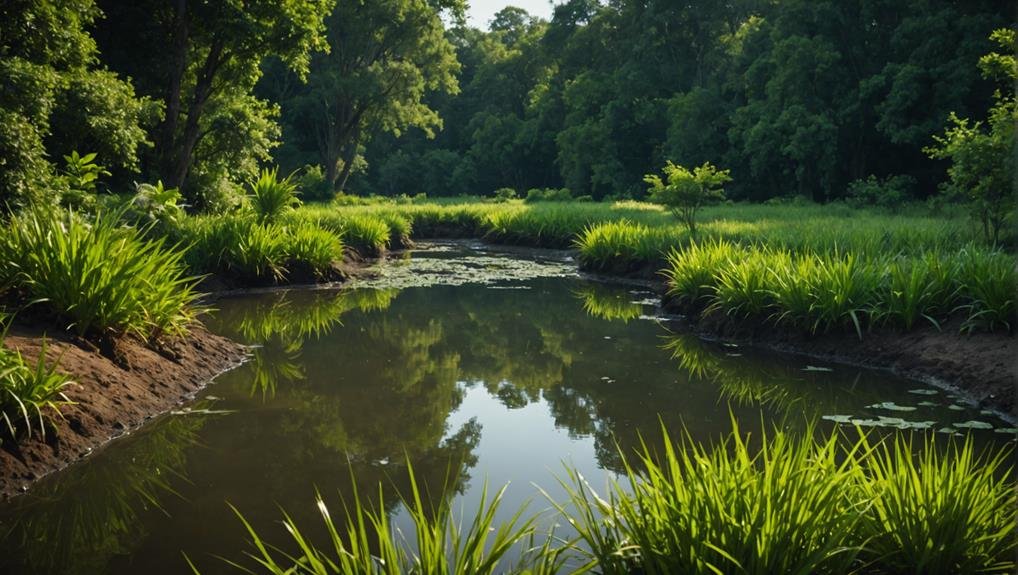To maintain a healthy pond environment, it's crucial to keep an eye on the water levels for any sudden drops that may indicate a leak.
Wet spots or muddy areas along the pond banks are telltale signs of water seepage.
Keep an eye out for excessive algae growth or unexpected fish deaths, as these could be indicators of imbalances caused by leaks.
Conduct daily checks and consistently compare water levels to catch any issues early on.
By observing these signs closely, we can ensure our pond remains in good condition.
Let's delve into other signs to watch out for and ways to prevent pond leaks.
Sudden Water Level Drops
It's crucial to monitor our pond for sudden drops in water levels as they could indicate a potential leak. When we observe a significant, quick, or uneven decrease in the water level, it's a clear sign that something might be amiss. Checking our pond's water levels daily is key because spotting leaks early can help us save time and resources.
Differentiating between normal water loss from evaporation and that caused by a leak is essential. Evaporation rates can fluctuate depending on factors like temperature and location. For example, on hot summer days, we may experience more water loss due to evaporation. However, if the water level decreases more than usual for our area and current weather conditions, it's worth investigating further.
To distinguish between regular evaporation and a potential leak, we can measure the water level at the same time every day. Gradual, minor drops are typically due to evaporation, but sudden fluctuations indicate a leak. By staying alert and recognizing these usual patterns, we can detect leaks early and address them before they escalate.
Keeping a watchful eye on our pond's water levels, understanding the causes of water loss, and promptly addressing any irregularities can help maintain the health and integrity of our pond.
Wet Spots on Pond Banks
Noticing damp areas on the edges of the pond can signal a potential leak in the liner or surrounding areas. These wet patches often look muddy and feel more moist than the rest of the bank, indicating possible water seepage through cracks, tears, or damaged sections in the pond liner.
Regularly checking for leaks is crucial to prevent further harm. Monitoring the size and spread of these wet spots helps determine the leak's location and severity, making it easier to plan for necessary repairs. By consistently keeping an eye on these signs, managing pond maintenance becomes more effective.
Taking swift action upon spotting wet patches can help avoid significant water loss. If left unattended, these leaks can worsen, necessitating more extensive and costly fixes. By conducting routine inspections of the pond's banks, early detection of these issues can lead to timely interventions.
Excessive Algae Growth

When checking for wet spots on pond banks, it's crucial to also keep an eye on excessive algae growth. This overgrowth can indicate imbalances in nutrients and poor water quality, as algae thrive in nutrient-rich environments often caused by organic decay or fish waste. An increase in algae can be a warning sign that the pond's ecosystem isn't in a healthy state.
Monitoring algae levels is vital because too much algae can deplete oxygen levels, harming aquatic life. Algae blooms can quickly take over a pond, impacting water quality and the overall ecosystem health. It's important to watch for changes in water clarity and level, as these can point to potential leaks or other issues in the pond.
To manage algae growth, proper filtration and aeration are key. Decreasing nutrient inputs by controlling fish feed and runoff can also be beneficial. Regular maintenance and water testing are essential to prevent algae blooms and maintain a thriving pond ecosystem.
Unexpected Fish Deaths
When fish suddenly die in a pond, it can signal a possible leak, which can disrupt the water quality and oxygen levels, leading to fish stress and mortality. Monitoring fish behavior is crucial to catch early signs of trouble. Keep an eye out for fish gasping at the surface or displaying distress, as these could indicate low oxygen levels linked to a leak.
To prevent unexpected fish deaths, there are a few key points to consider:
- Watch Fish Behavior: Regularly observe for unusual behaviors like gasping or erratic swimming, which may point to low oxygen levels due to a leak.
- Test Water Quality: Check water parameters such as pH, ammonia, and nitrate levels frequently. Poor water quality can stress fish and make them more prone to illness.
- Ensure Adequate Oxygen: Maintain proper aeration in the pond to prevent stagnant water from causing oxygen levels to drop and lead to fish deaths.
- Inspect the Pond: Regularly inspect the pond for signs of water loss, cracks, or damage that could indicate a leak.
Monitoring Daily Water Levels
Monitoring daily water levels is crucial to quickly identifying any potential pond leaks. By closely observing the water levels in our ponds on a regular basis, we can promptly spot any unusual drops that may indicate a leak. This proactive approach allows us to catch significant or consistent decreases in water levels, which are early indicators of possible issues. Keeping a record of these fluctuations helps us track trends over time, providing valuable insights into what's normal for our specific pond.
Comparing water levels at different times during the day can offer valuable clues about potential leaks. For example, if we observe a significant drop in water level overnight that stabilizes during the day, it may suggest a leak that's more active in cooler temperatures. By consistently monitoring and documenting these variations, we can detect leaks early and prevent extensive damage.
While some water loss due to evaporation is expected, especially in hot weather, abnormal or excessive drops should raise concerns. Regular checks and detailed records are essential tools for maintaining healthy ponds and avoiding the complications and costs associated with undetected leaks.
Wildlife Behavior Changes
Noticing changes in how wildlife behaves around our pond can signal potential leaks and water quality issues. When animals and aquatic life start acting differently, it's often a sign that something is wrong. Here are some key things to look out for:
- Fish Gasping: If you see fish gasping at the surface, it means they're struggling to breathe due to low oxygen levels in the water, which is usually caused by poor water quality.
- Altered Feeding Patterns: Birds or other pond animals changing where or how they feed could indicate a lack of food due to water problems.
- Unusual Movements: Watch for fish behaving strangely or avoiding certain parts of the pond, as this could be a sign of stress from bad water conditions.
- Decreased Activity: Keep an eye out for frogs or other amphibians showing less activity or odd behaviors, which could be their way of reacting to worsening water quality.
Inspecting for Erosion and Sinkholes

Regularly inspecting our pond for erosion and sinkholes is crucial to maintaining its health. Erosion can be identified by visible signs such as soil displacement, exposed roots, or collapsing banks, indicating potential water loss due to weakening soil structure. Sinkholes near the pond are another important indicator of underground leaks or soil erosion, often leading to significant water loss.
Keeping an eye out for sudden depressions or soil movements can help us catch these issues early. Monitoring changes in the landscape is key. If any unexpected soil movement is observed, it's vital to investigate further. Addressing erosion and sinkholes promptly can prevent further damage not only to the pond but also to its surroundings. This proactive approach is essential for preserving the pond's integrity and maintaining it as a healthy ecosystem.
Conclusion
In short, by watching for sudden drops in water levels, wet spots on pond banks, excessive algae growth, unexpected fish deaths, and changes in wildlife behavior, we can detect leaks early on.
It's crucial to monitor daily water levels and check for erosion or sinkholes to proactively manage any issues. Recognizing these signs early is key, as it enables us to promptly address problems and maintain a thriving pond ecosystem.
Let's remain vigilant and ensure our ponds are always in top condition.

